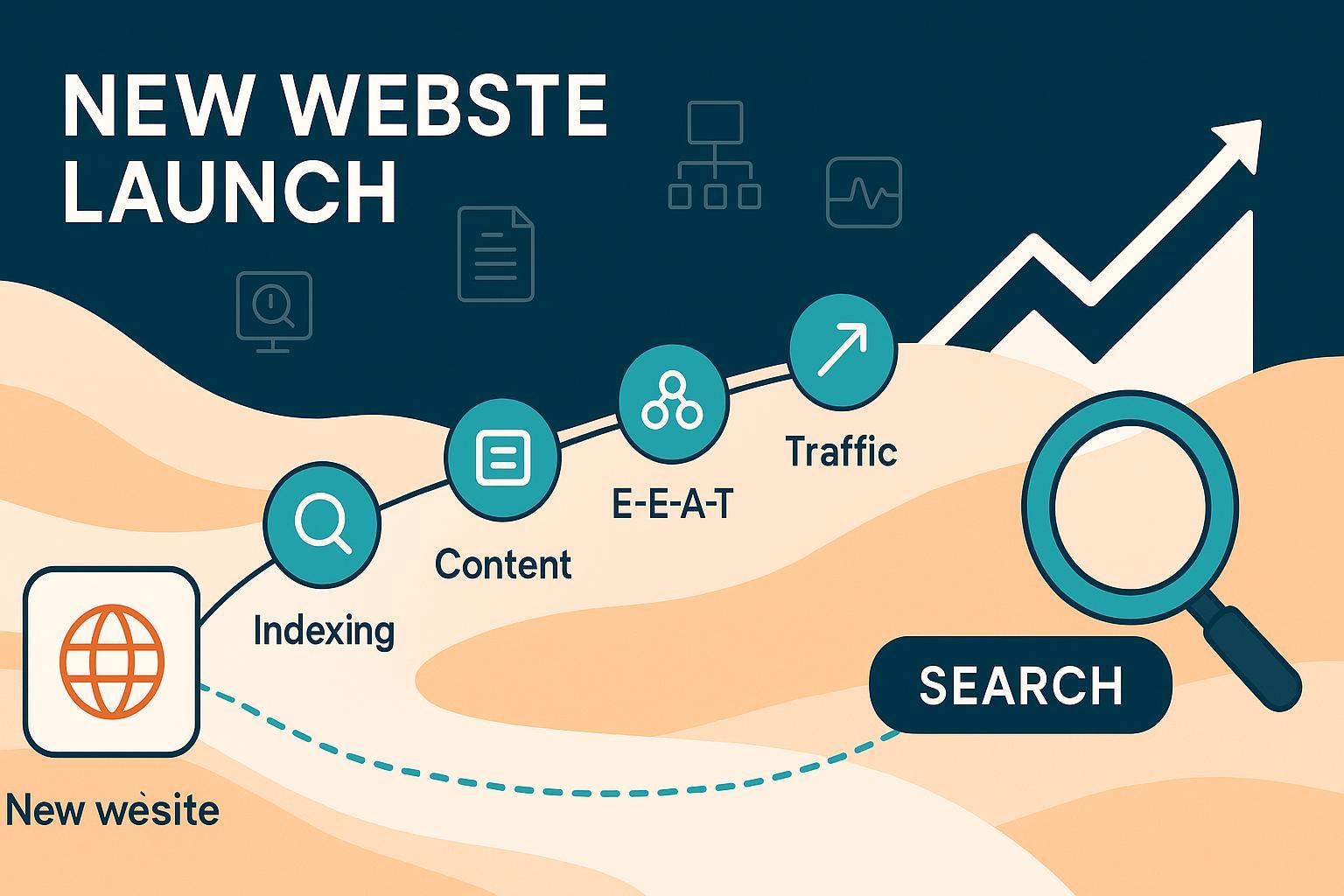How to Get Through the New Site Sandbox Period

Launching a new website rarely yields immediate organic wins. Most sites experience a period of limited search visibility in the first months—often called the “sandbox.” Google doesn’t confirm a formal filter, but early volatility is real: algorithms need time to evaluate quality, relevance, and trust. In practice, I’ve found 3–6 months is a typical ramp for new sites, with faster or slower outcomes depending on niche competition and execution.
Below is a battle-tested playbook you can implement from day one. It prioritizes technical correctness, people-first content, replicable authority building, diversified discovery, and ongoing measurement—while keeping you on the right side of modern spam policies.
1) What the “sandbox” really is (and isn’t)
- Google representatives have repeatedly clarified there’s no literal “sandbox,” but new sites undergo testing until enough signals accumulate. This explains early ranking movement as quality assessment rather than an intentional suppression. A helpful recap of these statements is in the Positional overview of Google’s sandbox discussion, which collates quotes from Google office hours over several years.
- Expect gradual, uneven visibility growth. Some pages may briefly rank and then settle; others may require iterative improvements and external signals before they stabilize.
- Your job: keep giving algorithms high-confidence signals—fast indexing, clean technical setup, helpful content that matches intent, and legitimate mentions/links.
2) Months 0–3: Technical launch checklist
Treat the first 90 days like a reliability sprint. Get the foundation right so every crawl converts into durable signals.
- Verify your property in Google Search Console, submit clean XML sitemaps, and use URL Inspection for key pages. Follow the latest guidance from Google Search Console recommendations (2024).
- Canonicals and sitemaps must agree. Only list canonical URLs in sitemaps and ensure rel=canonical points to them. See Google’s canonicalization guide.
- robots.txt hygiene. Don’t block essential resources (CSS/JS/images). Place robots.txt at site root and use it to keep low-value areas out of crawl. Start with the robots.txt introduction.
- Mobile-first parity and HTTPS. Ensure the same content, metadata, and structured data on mobile and desktop; use responsive design; enforce sitewide HTTPS. Google’s SEO Starter Guide is a concise baseline.
- Optimize Core Web Vitals, with special attention to INP (Interaction to Next Paint). Fix large images, heavy scripts, and main-thread blocking. INP became a ranking signal, as described in Google’s INP announcement (2023).
- Structured data for clarity. Add Organization/Person, Article/Product, FAQ/HowTo, and Breadcrumb where relevant; validate using Google’s tools. This improves how systems understand entities and page purpose.
- Crawl budget basics. Keep architecture clean: no orphan pages, logical internal linking, minimal duplication. Use Search Console’s Crawl Stats and Coverage reports to catch waste early.
Tip: Track a short list of technical KPIs weekly—indexation rate, Coverage errors, INP/LCP/CLS medians, and crawl anomalies. Foundation fixes compound faster than any other improvements in month 0–3.
3) Content that cuts through early volatility
Create helpful, original content that answers real user questions. Structure it so search systems can easily verify relevance and expertise.
- People-first helpful content. Google integrated “helpful content” concepts into its core systems in 2024. Focus on utility, originality, and experience signals. See the policy context in Google Search Central’s March 2024 core update and spam policies.
- Topical clusters and internal linking. Organize around pillar pages and supporting clusters that cover subtopics thoroughly. This helps systems infer topical authority and reduces thin content risk. For a practical primer, use the Backlinko topic clusters guide.
- Entity-first writing. Clarify “who/what/where” entities and relationships; reinforce with structured data and consistent naming. This aids understanding for modern AI-assisted search experiences. Google’s perspective on AI-driven discovery is outlined in Succeeding in AI Search (2025).
- Intent alignment. Map keywords to tasks: informational guides, how-tos, comparisons, local service pages. Write with the terms and steps users actually use.
Execution detail:
- Publish a pillar page early, then add 3–5 cluster articles per week for the first 6–8 weeks.
- Embed concise FAQs that answer direct questions; use clear subheadings and summaries. This helps both users and AI-mode summaries.
- Maintain update dates and changelogs on evolving posts; show experience and iteration.
For a beginner-friendly overview of SEO foundations, you can cross-check this with SEO explained for definitions and mental models.
4) Authority-building you can replicate safely
Avoid shortcuts. Focus on tactics that consistently earn mentions and links without tripping modern policies.
- Digital PR: Publish data-led or story-led assets worthy of coverage; pitch to relevant journalists/newsletters.
- Resource pages and curated lists: Find relevant “best resources” pages and suggest your guide as an addition.
- Expert sourcing: Contribute quotes or insights via interview roundups and Q&A platforms.
- Broken link building: Offer your article as a replacement for dead links on relevant pages.
- Unlinked-mention reclamation: Monitor brand/name mentions and request a link where appropriate.
Stay inside the lines: Google’s policies prohibit manipulative link schemes. Review the boundaries in the Google spam policies (2024). When links are paid or sponsored, label with the appropriate attributes per Google’s guidance on link crawlability and attributes.
If you need a step-by-step outreach blueprint, this practical walkthrough of a proven process can help: link-building guide.
5) E-E-A-T and trust signals that shorten the ramp
The fastest way out of early uncertainty is to appear real, competent, and accountable.
On-site basics:
- Author bios with credentials and relevant experience.
- Transparent About/Contact with real business details.
- Publication and update dates; revision notes on major changes.
- HTTPS, accessible UX, and clear navigation.
- Organization/Person/Article schema on relevant pages.
Off-site proofs:
- Earned citations from authoritative websites.
- Legitimate directory listings for local businesses.
- Reviews, testimonials, and community presence.
Google’s evaluators use E-E-A-T principles to assess quality; see the official Search Quality Rater Guidelines (PDF, updated regularly). Also review Google’s perspective on page experience signals to ensure your site meets usability expectations.
6) Diversify traffic early (indirect ranking benefits)
Social and community channels are not direct ranking factors, but they accelerate discovery, earn mentions, and seed branded searches.
- Share content in relevant communities, niche forums, and social channels.
- Build an email list from day one; promote new articles to subscribers.
- Consider small paid experiments to test messaging and attract early readers.
As John Mueller has noted in multiple Q&As, social signals themselves don’t directly move rankings; benefits are indirect. A balanced explanation is in the Ahrefs discussion of social signals and SEO.
7) Measurement and troubleshooting SOPs (0–3, 3–6, 6–9 months)
Make decisions with data. Track a small set of metrics that correlate with discoverability and user satisfaction.
Months 0–3:
- Search Console: verify, submit sitemaps, fix Coverage errors/exclusions; request indexing for priority URLs. See how to use Search Console.
- GA4: validate events and conversions; monitor engaged sessions and exit patterns.
- Core Web Vitals: baseline LCP/CLS/INP via PageSpeed Insights and GSC. Address big wins first.
- Crawl analysis: review Crawl Stats, duplication, canonical conflicts, and soft-404s.
Months 3–6:
- Segment Performance data by query, page, and country; prioritize pages with impressions but low CTR.
- Keep sitemaps fresh; mark lastmod correctly; clean up “valid with warnings.”
- Deepen CWV improvements: image optimization, lazy-loading, code splitting, caching.
- Periodic site audits to find thin pages or internal orphaning.
Months 6–9:
- Enhance structured data coverage; resolve persistent indexing issues.
- Analyze retention via GA4 cohorts; improve UX on high-exit pages.
- Consider infra upgrades: CDN, server response optimization.
- Prune or consolidate low-value content; merge overlapping articles and redirect.
If you prefer working in time-boxed initiatives, this primer on implementing SEO sprints offers a practical cadence.
8) Advanced tactics: benefits, risks, and modern policies
Some strategies can accelerate authority—but many now carry real risk.
- Expired domains and domain mergers: Historically used to inherit authority faster. Since 2024, Google explicitly calls out “expired domain abuse” and similar manipulations. The warning is part of the March 2024 core update and spam policies. Proceed only if there’s a legitimate, transparent continuation of purpose with high editorial standards.
- Site reputation abuse: Hosting third-party content to exploit your domain’s trust is now covered more strictly; Google updated this policy in November 2024. Review the site reputation abuse update (Nov 2024) before considering any partner content models.
- Scaled content abuse: Mass-generating low-value pages (including with AI) is risky. Systems are better at detecting commodity content. Focus on depth, originality, and experience.
Industry commentary that contextualizes enforcement trends is available in the 2024 coverage by Search Engine Journal on spam policy updates.
9) Tools workflow to speed execution (without cutting corners)
A lean toolkit helps you move faster in months 0–6:
- Google Search Console and PageSpeed Insights for indexing and CWV checks.
- A crawler (e.g., Screaming Frog or Sitebulb) for technical audits.
- Analytics (GA4) for engagement and conversion tracking.
- Outreach CRM or spreadsheet for link-building and PR.
- An AI-assisted writing and editing platform to systematize briefs, outlines, draft quality, and multilingual optimization.
For the last item, platforms like QuickCreator can streamline outlines, SEO metadata, multilingual drafts, and publishing workflows in one place. Disclosure: QuickCreator is the publisher’s product; this mention is for illustrative workflow purposes, not a performance guarantee.
10) Timelines and realistic benchmarks
Set expectations early so stakeholders stay patient and focused:
- In aggregated datasets, new pages rarely reach the top 10 quickly. Ahrefs’ longitudinal analysis indicates that only about 1.74% of newly published pages rank in the top 10 within a year, with older pages dominating results; see the methodology and context in the Ahrefs time-to-rank study (updated 2025).
- Visibility typically grows unevenly. Use proxy metrics like impressions, average position, and branded searches to assess momentum.
- In competitive niches, assume a 6–12 month climb to consistently meaningful organic traffic. In less competitive spaces, 3–6 months is achievable with disciplined execution.
11) FAQs and mythbusting
- “Is there a fixed 6-month sandbox?” No. Timelines vary by niche difficulty, content quality, and authority signals. Google does not operate a formal waiting-period filter.
- “Do social shares boost rankings?” Not directly. They help via discovery, links, and brand queries.
- “Can I publish thousands of AI articles to speed things up?” Quantity alone triggers risk today. Focus on depth, usefulness, and firsthand experience. Scaled content abuse is addressed in modern spam policies.
- “Should I buy links?” Paid links must be disclosed with proper attributes; manipulative link schemes can cause penalties or demotions.
- “Do Core Web Vitals really matter?” They’re not the sole ranking factor, but poor UX slows adoption and can undermine early momentum. Prioritize INP, LCP, and CLS.
12) If you’re stuck in month 4, 6, or 9: triage checklist
When you feel plateaued, run this quick audit and act within two weeks:
- Indexing and coverage: Any “Crawled — currently not indexed” or canonical conflicts on key pages? Fix duplication and thin content; request indexing after substantial updates.
- Content-market fit: Do your pillar pages satisfy the full intent? Add missing sections, examples, FAQs, and original research/data.
- Internal linking: Are clusters tightly linked to the pillar with descriptive anchors? Reduce orphan pages; surface important pages in navigation.
- Authority signals: Ship one linkable asset and actively pitch 20–30 qualified prospects; reclaim unlinked mentions.
- CWV: Address the worst offenders first—oversized images, render-blocking scripts, and slow TTFB.
- Diversified discovery: Promote via email and communities; run a small paid test to validate angles and collect feedback.
- Measurement: Identify pages with impressions but low CTR—improve titles/meta descriptions; test schema additions.
Final notes
There’s no silver bullet for the early visibility phase. The fastest way through is steady, high-signal execution: clean technical foundations, helpful content organized into topical clusters, earned authority, and diversified discovery—measured and improved every week. That consistency builds the trust and clarity modern search systems need.

